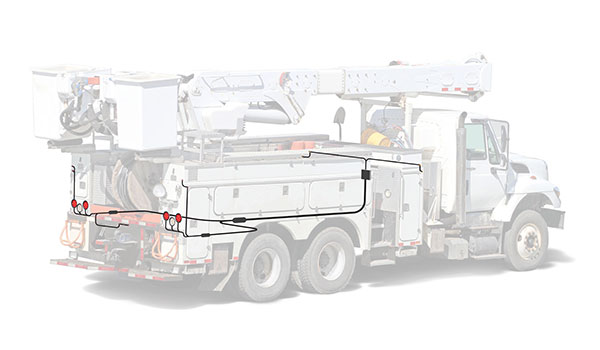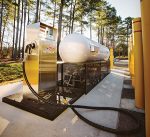In the world of electrical system and harness design for work trucks, variables are not only a challenge, they are the norm. There is little to no standardization for electrical connectivity among different chassis manufacturers, nor is there consistency between different models of a particular make of chassis. The variability among OEM electrical systems is something that work truck upfitters and bodybuilders must cope with from the start.
From the most basic service vehicle to the most sophisticated, high-tech vocational equipment, power needs are dictated by the work to be performed. With vehicle connectivity on the rise and more and more power-hungry systems on board, getting the power where it’s needed and keeping it there is proving more difficult.
Upfitters, bodybuilders, and specialty vehicle manufacturers have to start with what they have in front of them. The chassis they are using may have a connector of some kind that they can mate with, or they may find a blunt-cut cable end, in which case they will have to splice into it to form their electrical connection.
“In the past, we would see what is commonly referred to as ‘wire and loom’ systems for electrical distribution in most work trucks,” Brett Miller, engineering manager for Optronics USA Harness, says. “These convoluted systems would often be rather primitive affairs wrapped in plastic with wires exiting out of the core loom. They offered high flexibility, but were low on durability.”
A TANGLED WEB
According to Miller, the weakness of wire and loom systems is their inherent instability and vulnerability to contamination. Most wire and loom systems are informally constructed with spliced connectors at the wire ends that may not be properly sealed against the elements. The systems also generally have too little protection around the main loom, and the protection they do have is compromised by the many openings needed to enable individual wires to exit.
Some wire and loom systems may incorporate wire that is undersized and unable to handle the demands placed on it. In these cases, wires can heat up to such an extent that their outer sheath may melt, become brittle, crack, and in severe cases, cause a vehicle fire.
“The big problem is moisture,” Miller says. “Moisture enters an electrical system through even the smallest breach in the protective outer jacket and penetrates through insulation, ultimately reaching the conducting wire.”
Connectors are also a primary source for moisture intrusion and electrical system contamination. Connectors become more vulnerable over time because the dielectric grease that once repelled dirt and water dries out, reducing its effectiveness as a protective barrier.
Once water has entered the electrical system it’s only a matter of time before it fails. Physics and the mechanical action of the wires and cables as the vehicle moves can literally cause the moisture to migrate throughout the entire electrical system.

OVER AND OVER
To combat the effects of moisture on electrical wires, it’s best to use wiring and harness systems built specifically to take what a work truck can dish out. One company, Optronics USA Harness, works with upfitters, bodybuilders, and specialty vehicle manufacturers to custom engineer a wiring and harness system that not only serves its purpose, but lasts for the service life of the vehicle. Systems are laid out only after a complete and thorough understanding of a vehicle, its structure, and its field application is established.
“We design fully-jacketed cable assemblies with over-molded splices and plug-in connectors,” Miller says. “Our durable PVC plastic material envelops all the wiring in a protective outer layer that resists multiple forms of contamination, including moisture.”
Miller notes that a well-designed system really pays off in the long run because it reduces the vehicle owner’s exposure to electrical problems down the road. All Optronics USA Harness systems are designed to handle severe-duty on- and off-highway applications. This added level of protection benefits all users, including those operating in less demanding environments.
A DIFFERENT ROUTE
Work truck designs often make it necessary for wires and cabling to pass through walls and structural members. Whenever metal comes into contact with any branch of an electrical system’s outer jacket, there is a chance that abrasion will occur, ultimately resulting in a breach.
Optronics USA Harness engineers look for ways to avoid problem areas where possible. When passing through a metal surface is impossible to avoid, the company recommends applying rubber grommets to reduce the potential of wear and damage.
Additionally, box truck wiring is usually a straightforward exercise, according to Miller. Power is typically needed for stop, tail, turn, marker, and back-up lamps, and maybe interior dome lamps. But with last-mile delivery on the increase, reefer, pallet jack charging, and liftgate wiring scenarios are increasing with it.
“The basic task on a box truck is to get the wiring from the bottom of the box to the top,” Miller states. “We design box truck cables and overmolding with as few connection points as possible.”
BOOMERS & WRECKERS
Boom cranes and their bodies present numerous electrical and wiring challenges. Because of their auxiliary lighting and the variety of specialized functions often found on these vehicles, the systems can be quite complex.
“On a boom truck, we’re often running power to a wide variety of systems, including lots of work lights,” Miller says. “You’ll see everything from hydraulics, pneumatics, inverters, controllers, and much more, including sensors on the boom that monitor the level of extension.”
Wreckers come in many varieties, from small to heavy-duty to roll-on ramp versions. Many are highly customized for their particular application.
“One of our customers is a large global wrecker manufacturer, offering one of the industry’s broadest arrays of wrecker designs,” Miller says. “In their case, flexibility is the key, so we build a cable backbone that feeds into a hardened junction box.”
Miller notes that the junction box Optronics USA Harness uses is made of highly resilient acrylonitrile butadiene styrene (ABS). ABS is an opaque thermoplastic polymer that is easily molded. The amorphous plastic has a high tensile strength and is highly resistant to physical impact and chemical action, which makes it perfect for use in challenging environments.
The 10-stud junction boxes can accommodate more dedicated circuits than a standard seven-stud system. As with boom trucks, wreckers must often support a variety of subsystems including auxiliary lighting, hydraulics, pneumatics, inverters, and controllers.
PERFECT HARMONY
When designing a vehicle’s electrical and power delivery system, it’s critical to start with the best connection to the chassis’ OEM wiring system and work from there out. Once the body dimensions and structural elevations are all in place and the dependent system coordinates are located, the system designer can set about routing the cable and wiring in the most efficient and effective method possible.
“Optronics USA Harness makes harness and electronic control systems for a wide variety of vehicles, but with almost 30 years of experience in just the specialized field of work truck electrification, we’re very adept at customizing systems that are amazingly effective and robust,” Miller says. “There are simpler and less expensive ways to electrify a work truck, but there is no better way than to go with an expert in this field.”
FOR MORE INFORMATION
Find out more about Optronics
USA Harness, visit www.optronicsinc.com.




